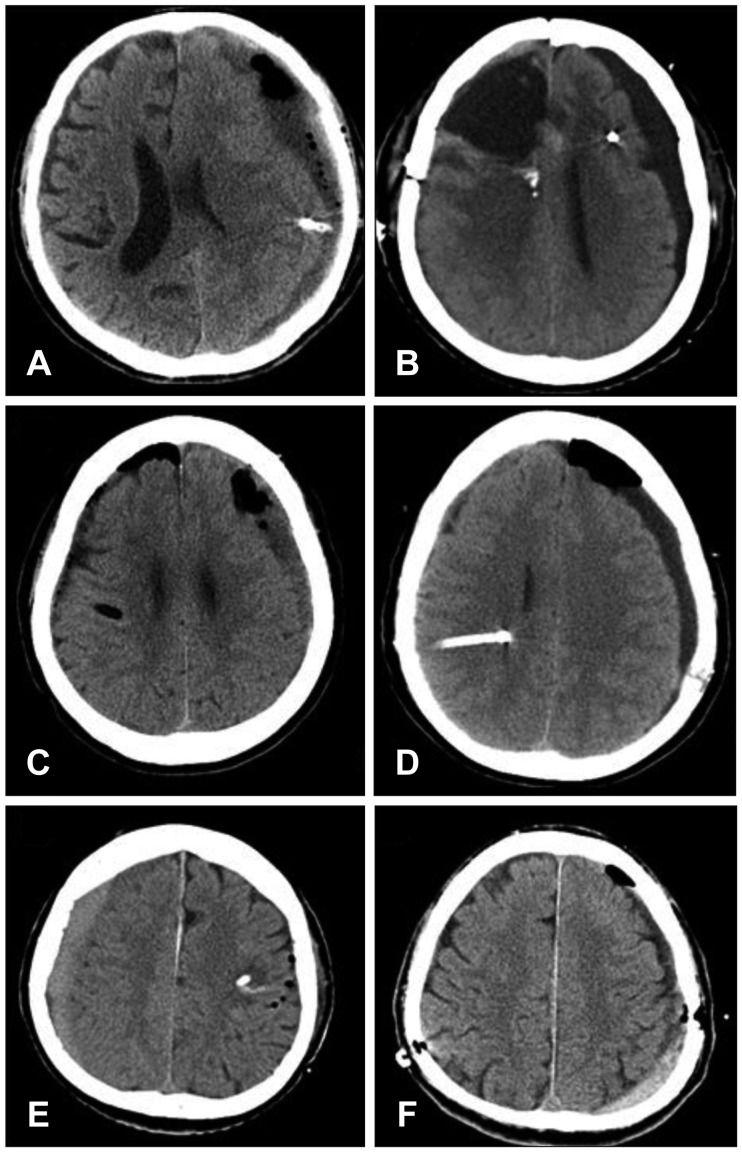Korean J Neurotrauma.
2018 Oct;14(2):68-75. 10.13004/kjnt.2018.14.2.68.
Complications Following Burr Hole Craniostomy and Closed-System Drainage for Subdural Lesions
- Affiliations
-
- 1Department of Neurosurgery, Konkuk University Medical Center, Konkuk University School of Medicine, Seoul, Korea. his4u2@hanmail.net
- KMID: 2424315
- DOI: http://doi.org/10.13004/kjnt.2018.14.2.68
Abstract
OBJECTIVE
Burr hole craniostomy and closed-system drainage (BCD) is a common surgical procedure in the field of neurosurgery. However, complications following BCD have seldom been reported. The purpose of this study was to report our experiences regarding complications following BCD for subdural lesions.
METHODS
A retrospective study of all consecutive patients who underwent BCD for presumed subdural lesions at one institute since the opening of the hospital was performed.
RESULTS
Of the 395 patients who underwent BCD for presumed subdural lesions, 117 experienced surgical or nonsurgical complications. Acute intracranial hemorrhagic complications developed in 14 patients (3.5%). Among these, 1 patient died and 5 patients had major morbidities. Malposition of the drainage catheter in the brain parenchyma occurred in 4 patients, and opposite-side surgery occurred in 2 patients. Newly developed seizures after BCD occurred in 8 patients (2.0%), five of whom developed the seizures in relation to new brain lesions. Eighty-eight patients (22.3%) suffered from nonsurgical complications after BCD. Pulmonary problems (7.3%) were the most common nonsurgical complications, followed by urinary problems (5.8%), psychologic problems (4.3%), and cognitive impairments (3.8%).
CONCLUSION
The incidence of complications after BCD for subdural lesions is higher than previously believed. In particular, catastrophic complications such as acute intracranial hematomas and surgical or management errors occur at rates that cannot be ignored, possibly causing medico-legal problems. Great caution must be taken during surgery and the postoperative period, and these complications should be listed on the informed consent form before surgery.
MeSH Terms
Figure
Reference
-
1. Bernstein M. Wrong-side surgery systems for prevention. Can J Surg. 2003; 46:144–146. PMID: 12691358.2. Chari A, Hocking KC, Broughton E, Turner C, Santarius T, Hutchinson PJ, et al. Core outcomes and common data elements in chronic subdural hematom: A systematic review of the literature focusing on reported outcomes. J Neurotrauma. 2016; 33:1212–1219. PMID: 26295586.3. Dindo D, Demartines N, Clavien PA. Classification of surgical complications: a new proposal with evaluation in a cohort of 6336 patients and results of a survey. Ann Surg. 2004; 240:205–213. PMID: 15273542.4. Ducruet AF, Grobelny BT, Zacharia BE, Hickman ZL, DeRosa PL, Andersen KN, et al. The surgical management of chronic subdural hematoma. Neurosurg Rev. 2012; 35:155–169. PMID: 21909694.
Article5. Gazzeri R, Galarza M, Neroni M, Canova A, Refice GM, Esposito S. Continuous subgaleal suction drainage for the treatment of chronic subdural haematoma. Acta Neurochir (Wien). 2007; 149:487–493. PMID: 17387427.
Article6. Gelabert-González M, Iglesias-Pais M, García-Allut A, Martínez-Rumbo R. Chronic subdural haematoma: surgical treatment and outcome in 1000 cases. Clin Neurol Neurosurg. 2005; 107:223–229. PMID: 15823679.
Article7. Goyal A, Singh AK, Gupta S. Acute extradural haematoma occurring during twistdrill craniostomy for chronic subdural haematoma. Br J Neurosurg. 2002; 16:294–295. PMID: 12201401.
Article8. Hennig R, Kloster R. Burr hole evacuation of chronic subdural haematomas followed by continuous inflow and outflow irrigation. Acta Neurochir (Wien). 1999; 141:171–176. PMID: 10189499.
Article9. Kolias AG, Chari A, Santarius T, Hutchinson PJ. Chronic subdural haematoma: modern management and emerging therapies. Nat Rev Neurol. 2014; 10:570–578. PMID: 25224156.
Article10. Kotwica Z. Treatment of chronic subdural hematoma by burr holes and closed-system drainage. Neurosurg Clin N Am. 2000; 11:503–505. PMID: 10918021.
Article11. Lin X. Comparing twist-drill drainage with burr hole drainage for chronic subdural hematoma. Chin J Traumatol. 2011; 14:170–173. PMID: 21635805.12. Panourias IG, Skandalakis PN. Contralateral acute epidural haematoma following evacuation of a chronic subdural haematoma with burr-hole craniostomy and continuous closed system drainage: a rare complication. Clin Neurol Neurosurg. 2006; 108:396–399. PMID: 16644405.
Article13. Pavlov V, Bernard G, Chibbaro S. Chronic subdural haematoma management an iatrogenic complication. Case report and literature review. BMJ Case Rep. 2012; DOI: 10.1136/bcr.12.2011.5397. [epub ahead of print].14. Rohde V, Graf G, Hassler W. Complications of burr-hole craniostomy and closed-system drainage for chronic subdural hematomas: a retrospective analysis of 376 patients. Neurosurg Rev. 2002; 25:89–94. PMID: 11954771.
Article15. Santarius T, Kirkpatrick PJ, Ganesan D, Chia HL, Jalloh I, Smielewski P, et al. Use of drains versus no drains after burr-hole evacuation of chronic subdural haematoma: a randomised controlled trial. Lancet. 2009; 374:1067–1073. PMID: 19782872.
Article16. Santarius T, Kirkpatrick PJ, Kolias AG, Hutchinson PJ. Working toward rational and evidence-based treatment of chronic subdural hematoma. Clin Neurosurg. 2010; 57:112–122. PMID: 21280503.17. Shenoy SN, Raja A. Acute epidural hematoma following twist-drill craniostomy for chronic subdural hematoma-a rare complication. Neurol India. 2003; 51:291–292. PMID: 14571043.18. Smely C, Madlinger A, Scheremet R. Chronic subdural haematoma--a comparison of two different treatment modalities. Acta Neurochir (Wien). 1997; 139:818–825. PMID: 9351986.19. Wang K, Chen D, Cao X, Gao L. A prospective comparative study of twist drill craniostomy versus burr hole craniostomy in patients with chronic subdural hematoma. Turk Neurosurg. 2017; 27:60–65. PMID: 27593747.20. Yonezawa K, Kim S, Tanaka M. Acute epidural hematoma following evacuation of chronic subdural hematoma with continuous closed system drainage. No Shinkei Geka. 1992; 20:1013–1016. PMID: 1407353.
- Full Text Links
- Actions
-
Cited
- CITED
-
- Close
- Share
- Similar articles
-
- Chronic Subdural Hematomas : A Comparative Study of Three Types of Operative Procedures
- One vs. Two Burr Hole Craniostomy in Surgical Treatment of Chronic Subdural Hematoma
- Clinical Analysis of Chronic Subdural Hematoma after Burr-Hole Craniostomy and Closed-System Drainage
- Burr Hole Drainage versus Small Craniotomy of Chronic Subdural Hematomas
- Factors Affecting the Reaccumulation of Chronic Subdural Hematoma after Burr-hole Trephination and Closed-system Drainage


